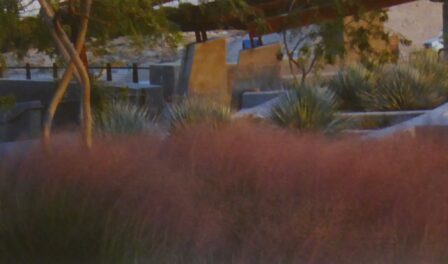A Lesson in Water Wise Gardens
In December I attended San Diego Horticultural Society’s meeting on Water Wise Lessons, given by Clayton Tschudy, director of Horticulture and Exhibits at The Water Conservation Garden in El Cajon. This garden represents nearly 20 years’ experience in using drought tolerant plants. Tschudy discussed the garden’s history, both success and challenges of the Garden and subsequent innovations inspired by the current drought situation.

This photograph looks like an impressionist painting due to the beautiful grasses and thin leaved trees.
In the two decades’ experience the garden has received an AIA Orchid Award for landscape design and a GEELA Award for education. Some of the photographs from when it won an Orchid Award look like impressionist paintings due to the beautiful grasses and thin leaved trees. It also won an APGA Award for small program Excellence. It has been featured in Sunset Magazine, Pacific Horticulture and others.
While showing us photos of the beautiful water wise garden, Tschudy began by describing the challenges. Besides surviving drought, the garden needs long term maintenance. In addition, our county’s less than ideal soil poses problems. Much of it is heavy clay on top of decomposed granite. When wet it holds water leading to root rot. When dry it morphs into a concrete like surface needing a jackhammer or back hoe to till.
Some innovations or recycled methods are now providing unusual (for us) methods to conserve water. One is bioswale. The gardener builds berms and digs long three-foot wide trenches with gently sloped sides. These are filled with sycamore or willow wood into which mulch and nitrogen are layered. Manure and green waste makes part of the mixture. A bucket set into the center of the trench serves as a place-holder for a tree to be planted in the future. A thin layer of soil may top these wood-filled trenches. Meanwhile, the filled trenches receive water regularly but not often in the first year. Two to three days after the first irrigation, the water will have been absorbed. Now seeds of drought-tolerant plants and cuttings can be sown to slow storm run-off and filter out pollutants. So far this method seems to be working in the Water Conservation Garden as the plants get water from the wood’s moisture, and additional water is rarely needed; in fact, normal rain water should sustain them. These bioswales are designed to remove silt and pollution from surface run-off water.
Hugelkultur is another efficient gardening method similar to but easier to build than bioswale. You build a hill of branches, leaves and grass clippings; adding straw, cardboard, newspaper, manure or compost. Top this with soil and plant your flowers, vegetables or groundcover. As the wood matter decays, it provides a constant source of food for at least 20 years. It also produces heat as it composts which may lengthen the growing season. As the breakdown of branches and logs continues, soil aeration increases eliminating tilling the soil. The logs and branches soak up water which is released during dry spells. This means after the first year, you will water only when there has been an extremely long drought. These beds can be huge, can be built as hills or mounds eliminating bending over and providing more planting surfaces. The larger the mass, the more water will be retained. You can build winding gardens or straight gardens or even a combination.
Another issue Tschudy discussed was dying succulents. Succulents succumb to over-watering. Their soil needs an amendment of pumice and gravel. These aid drainage and help keep roots dry while enabling the plant to get nutrients.
Whatever you plant, you must consider your local conditions and choose your plant materials carefully. Grouping plants with similar needs solves many problems not unlike putting students in classes according to their needs. Tschudy says to simplify sustainability and reap best results, copy nature.
Tschudy also advocates practicing “closed-loop” landscape maintenance. This is more than using an efficient irrigation technology. It means ensuring that what falls on the site (leaves, water and organisms), stays on the site. The garden becomes a habitat for a self-sustaining eco-system. Water and food are recycled and saved. Organic matter from water, plants, animals, and microbes provide food. In a successful closed loop landscape, a tiny bit of soil should contain one billion organisms (bacteria, fungi, protozoa, nematodes, arthropods and earthworms.) and ten million species of microbes. A handful of this healthy soil will have more creatures than there are humans on earth and hundreds of miles of fungal threads.
Your hardscape can help define the sustainable garden. If you use the bio-swale or the hugelkultur methods, following the land’s contours or choosing curving or linear designs, building walls or walkways adjacent to them will protect and delineate the planting areas. Remember that your garden has many systems within it, both aesthetically and physically. An eco-friendly environment is a healthy environment, encouraging plant growth, increasing oxygen, feeding the critters that preserve it, and saving human’s time, energy and money. Done well, it should be a feast for the eyes as well.
The topic of the January 20 meeting is Back Yard Labs where we will learn how aid science by keeping records of critters that frequent your yard. The meeting will be at the church at 4070 Jackdaw from 6 until 8 p.m.
Category: Events, Local News







